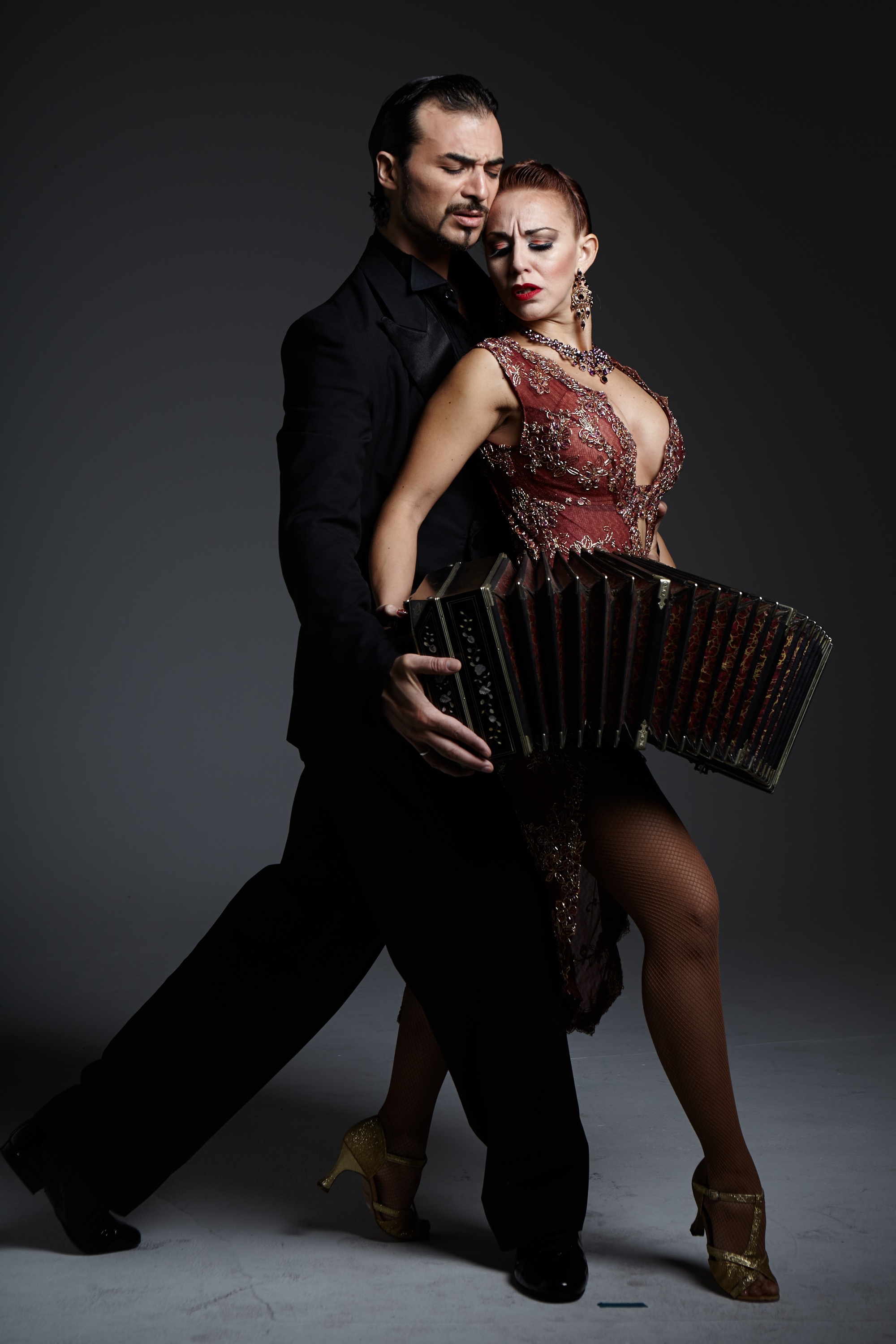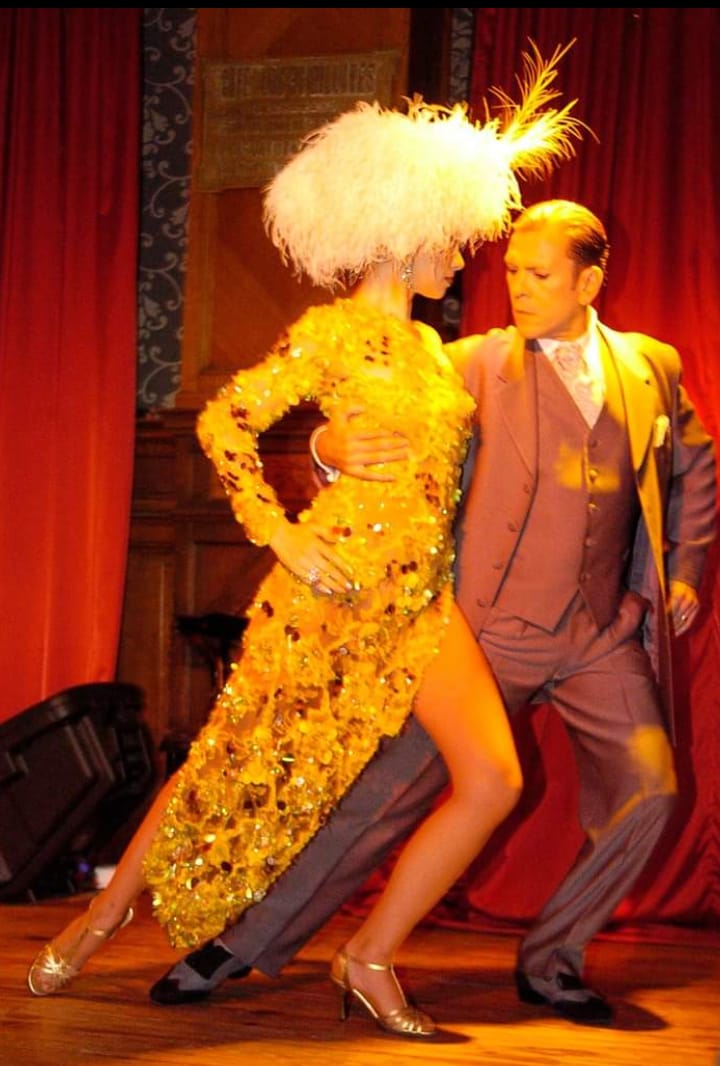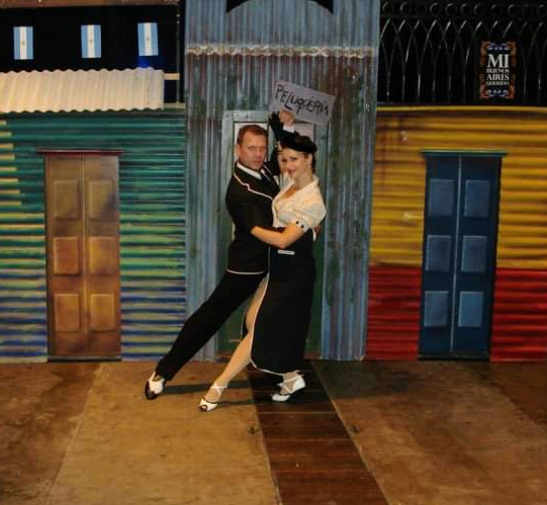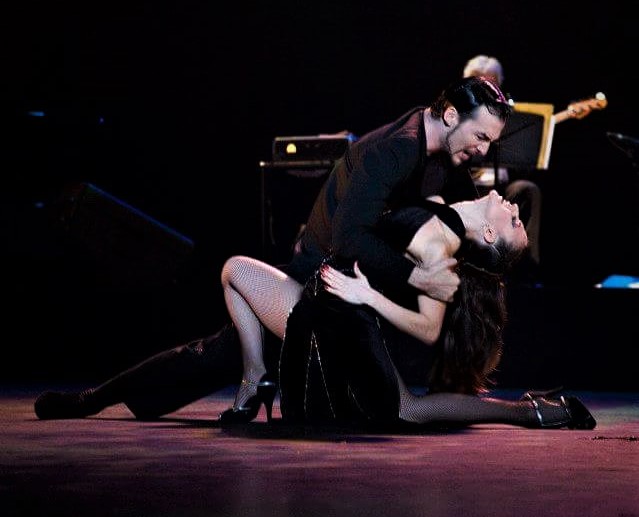As stated in a previous HO article (“Tango, An Inclusive Art”), “tango emerged naturally and spontaneously as a way of being and feeling that responded to the need for freedom and creative expression.
”Argentine Tango* was born in Rio de la Plata and encompasses five elements that developed and evolved, adopting, as time passed by, different approaches and defined styles.
Elements of Tango Dance
Music
Dancing is a manifestation of the body that reacts to an auditory stimulus. The music of tango that was rhythmic and accentuated in its origins has fused with other local and foreign rhythms. Performed with few instruments at the beginning, such as the flute, guitar and violin, it has gradually added other instruments such as the piano, bandoneón*, and double bass, generating a more complex rhythm and melody and many variants and arrangements, typical of the great orchestras of the Golden Age of Tango.

Socio-cultural context
At the very beginning, tango was criticized and judged by different social agents as indecent, linked to marginality, city outskirts and prostitution. The port cities of Buenos Aires and Montevideo welcomed immigrants who contributed with their own customs to make tango what it is today.
The Afro influence and the country people who settled down in the city were faced with European precepts that led to the shunning of tango. provoked a tango non-acceptance. However, as it became accepted in Europe, tango music, poetry, and dance filtered through all social classes and achieved the status of authentic art representing people’s needs.

Key Players
A varied array of actors who felt and experienced tango in an authentic way supported it over the years, such as Compadritos*, ruffians and prostitutes moving up to lower social classes in the outskirts and later on to upper social classes. Tango found a representation in each actor that led to its success. Musicians and singers representative of La Guardia Vieja (the most authentic period of tango) include one of the most famous tango singers of all time, Carlos Gardel. Among other musicians and singers are Eduardo Arolas, Alfredo Gobi, Flora Gobbi, Vicente Grecon, Juan Maglio, Linda Thelma and Lola Membrives. Dancers were also key to boosting tango in this period. One of the many dancers who gave tango worldwide popularity by taking it to Paris and New York was El Cachafaz (Ovidio Bianquet) in 1911 and 1912 in La Guardia Vieja period. Since then, countless dancers and instructors have committed to taking tango to every corner of the world, among whom Casimiro Ain (El Vasco), Carmencita Calderón, and José Giambuzzi (El Tarila) are worth mentioning, and more recently Juan Carlos Copes and María Nieves, Los Dinzels, Gloria and Eduardo Arquimbau, Miguel Ángel Sotto and Milena Plebs, Pepito Avellaneda, and Raúl Bravo.

Places
Brothels and cabarets witnessed the first steps of tango among compadritos*, chinas* and milonguitas*. The dirt floors played a major role since the shoes patterns left on them gave origin to many figures’ names, such as corridita* and ocho cortado*, took their names from the patterns that the shoes left on this kind of floor. They also prevented the development of steps like the pivot that was not in the Orillero or Canyengue style, for being impossible to make on this type of floor. Already in the Guardia Nueva, and as tango gained popularity and success and was danced in local clubs, academies, and ballrooms, the hostile floors were left behind. More suitable floors made it easier to spread movements with figures of invasion of space such as sacadas*, ganchos*, boleos*, and sanguchitos*. And they also gave way to a range of options for new steps such as turns, basic step, half turns, front change, and a more elegant embrace with an upright posture.

Outfits
Each era of fashion has played a decisive role in tango dancing, conditioning more or less bodily mobility. For instance, in the early days, tight clothing only allowed simple movements to slide across the floor. In the 1930s, women freed themselves from corsets and shortened their skirts to the knee, allowing more freedom of movement to create new figures.
Today, the wardrobe is elegant, and comfortable dancing shoes are used. While in stage tango the traditional clothing for males is tuxedos or suits with a bow or tie, for ladies they are dresses with a length to the knee or below the knee and a slit in the skirt that allows for better leg movement.

Evolution of Tango Dance
As a popular dance or exhibition dance, tango has undergone an evolutionary process in styles, each of which left its mark and gave rise to typical and distinctive figures, steps, embraces and body positions that defined the dance trend in each period. Among the more influential styles are:

Tango Orillero or Arrabalero
This is the tango from the outskirts of Buenos Aires and Montevideo, marginal areas inhabited by lower social classes. Afroamerican enslaved people injected this initial tango dance with their movements such as cuts, breaks, and walks. The linked couple style developed approximately between 1860 and 1890.

Tango Canyengue
This is a well-defined style with a close embrace and bodies in contact, separating the hips. The cortes* and quebradas* and movements such as sentaditas*, corriditas*, and ochos cortados* stand out. This period, called Guardia Vieja, took place approximately between 1897 and 1917. During this period, the tango dance leaves the port areas and moves towards the conventillos* and outer areas of the city.

Parisian or Refined Tango
After its success in Europe, the tango arrives in Buenos Aires with an elegant Parisian style, a more open embrace, and almost without body contact. This style, mainly adopted by the upper classes, did not transcend because it lost the connection that makes tango a sensual dance.

Salon Tango or Tango Pista
Tango Pista (as it is called today) placed itself between the Canyengue and the Parisian styles. Here, the bodies looked for elegance in the movement, and kept the embrace somewhat more open but maintaining contact. This style, which emerged between 1920 and the 1950s in ballrooms and public or family settings, avoided cuts and breaks and freed the legs from the floor, which gave rise to figures of space invasion such as sacadas*, barridos*, ganchos*, and boleos*, to name some. Also, some figures we use today appeared in this period, such as eights, the basic step, and changes of front.
While there was a set base for this style, each Buenos Aires neighborhood imprinted it with its own ways and mores, like Mataderos and Villa Urquiza, thus creating substyles. Another example is the Milonguero* Substyle or Style of the Center, which refers to singles who go to cafés in order to dance. This substyle highlights a closer embrace with torsos in contact, shorter steps, and no high movements.
Tango Pista is what we see today in milongas*, clubs, and ballrooms. The couple, made of partners who may know each other or not, connect through the embrace, which is fundamental for a smooth and improvised performance, and they move counterclockwise across the floor to the sound of an orchestra or a DJ.
Tango Nuevo
Born in the 80s, this is the most recent style in which tango incorporates a fusion of techno and electronic music as well as elements of salsa and a more open embrace. The embrace is broken to give freedom of movement and generate off-axis figures such as colgadas* and volcadas*.
Stage Tango or Fantasy Tango
Today, two categories with two well-defined styles are recognized by Buenos Aires Tango World Championship and festivals worldwide. One of them is Tango Pista, a more social dance, and the other is the Stage Tango or Fantasy Tango, which highlights the artistic creativity and qualities of the dancers. Fantasy tango is mostly choreographed on a specific musical theme. The embrace is broken to give way to more dramatic and acrobatic figures such as tricks and jumps. Dancers incorporate tools from other disciplines to achieve such imposing choreographies. One or various couples can develop their routines on glamorous, specially designed scenic stages.
Regardless of which tango style you choose to watch or dance, the moment you engage with tango, you engage with passion.
Tango terms:
Bandoneón: Concertina-like leading instrument in Tango orchestras.
Barrido: Sweep. When one partner moves his foot, displacing the other partner’s foot without losing contact.
Boleo: Back and forth movement of the follower’s free leg.
China: Lower-class, mixed race woman.
Colgadas and Volcadas: When one of both dancers open the embrace in an off-axis position and lean backward or forward.
Compadrito : Popular young man.
Conventillos: Large houses inhabited by numerous families, each occupying one room.
Corridita: Run. A walk that looks like a run.
Corte: Cut. Stop of movement.
Fantasía: Fantasy
Gancho: Hook. When the dancers hook their legs around each other.
Guardia Vieja: Old Guard, referring to the first generation of tango musicians.
Milonguero: Person who dances social tango or tango pista.
Milonguitas: Women aspiring for social mobility.
Nuevo: New.
Ocho: Eight. Side, forward and backward movements with combinations of pivots and crosses on eight count.
Ocho cortado: Cut eight. In this step, the eight figure is not interrupted.
Pista: The floor area, generally in front of the orchestra or in the ballroom center where dancers move.
Pivot: Rotation on the metatarsus without travelling.
Quebrada: Break. Variation of the cut. Sudden stop of movement.
Sacada: Displacement of the follower’s foot by the leading partner.
Sanguchito: Sandwich. When the follower’s foot is enclosed between the leader’s feet.
Sentaditas: When the female partner creates the illusion of sitting on the male partner’s leg.
Tango: A word of Afro origin, meaning the closed place where the enslaved people were gathered to be sent overseas.
Short Bio:
Alejandro Figliolo is a tango dancer, choreographer and instructor, President of the “Fundación Cultura y Arte Popular.” He finished his studies at the former Tango University, now CETBA in Buenos Aires. He has performed in Corrientes Avenue theaters in Buenos Aires and traveled worldwide with different tango companies.
Facebook (https://www.facebook.com/alejandro.figlio)
YouTube (https://www.youtube.com/channel/UCoBuio7OFsdrJqHNWCe7p6w)